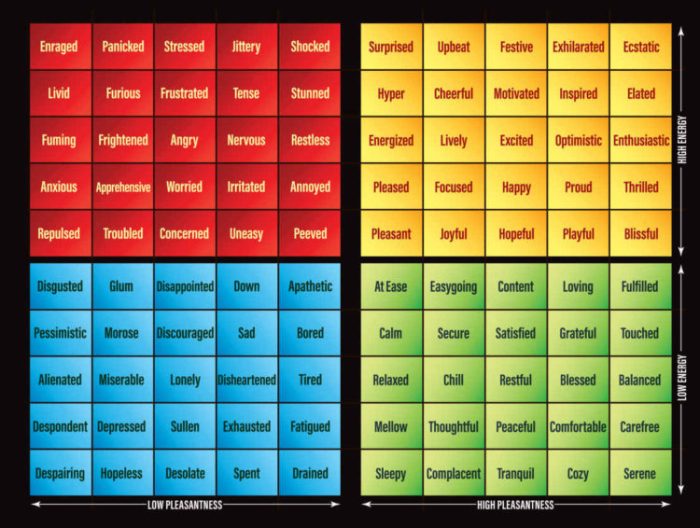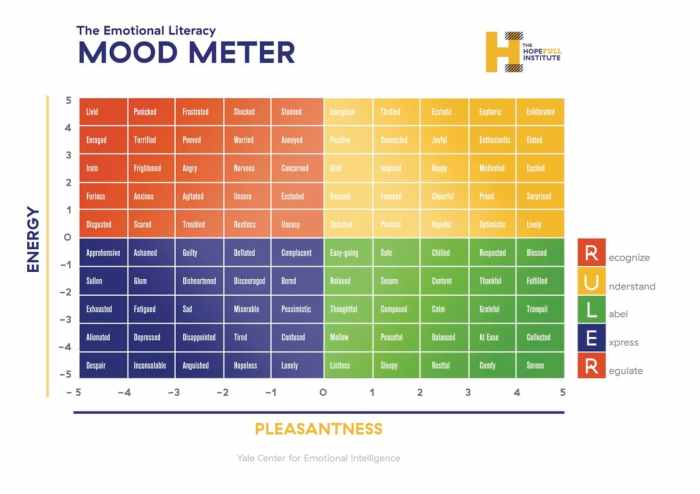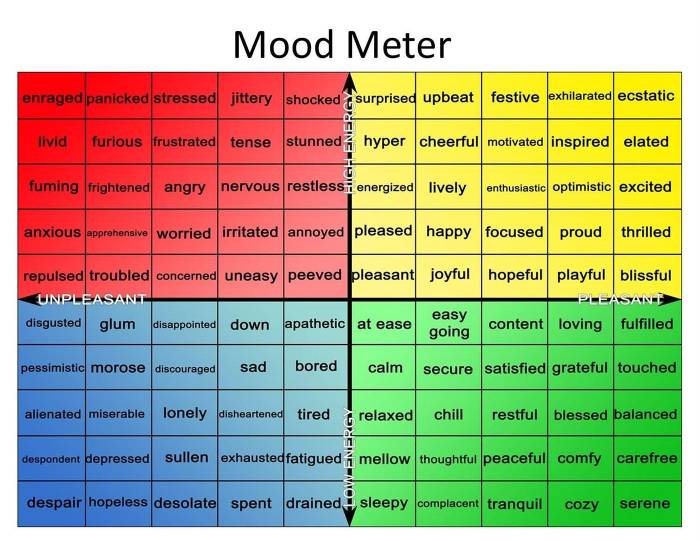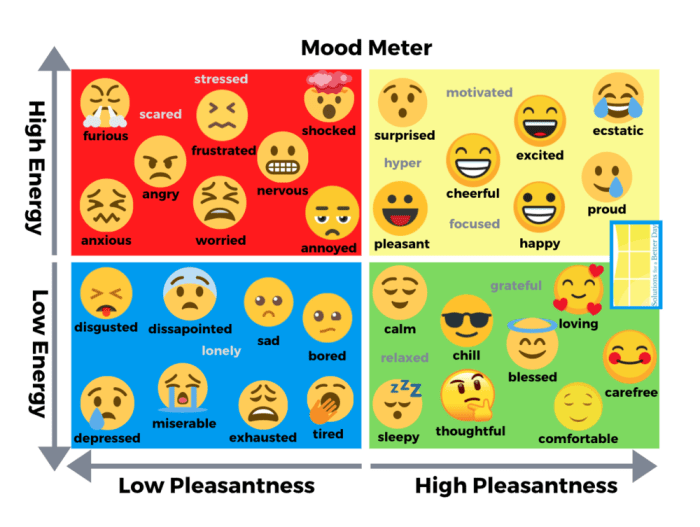Permission to Feel Mood Meter: A revolutionary tool that empowers you to understand and manage your emotions. Dive into this comprehensive guide to discover its benefits, challenges, and how it can transform your mental health and well-being.
Mood monitoring has emerged as a game-changer in the realm of emotional health. With Permission to Feel Mood Meter, you gain the ability to track, interpret, and make sense of your emotional experiences.
Understanding Permission to Feel Mood Meter

The concept of permission to feel is the idea that you have the right to experience your emotions without judgment or suppression. This means allowing yourself to feel both positive and negative emotions without feeling guilty or ashamed.
A mood meter is a tool that can help you track your mood over time. It can help you identify patterns in your mood and understand what triggers positive and negative emotions. This information can be helpful in managing your mood and improving your overall mental health.
Permission to Feel and Mood Monitoring
Permission to feel and mood monitoring are closely related. When you give yourself permission to feel, you are more likely to be aware of your emotions and to track them accurately. This information can then be used to identify patterns in your mood and to develop strategies for managing your emotions.
Benefits of Using a Permission to Feel Mood Meter

Monitoring your mood with a Permission to Feel Mood Meter offers a myriad of advantages that can significantly enhance your emotional well-being. By tracking your moods over time, you gain valuable insights into your emotional patterns, triggers, and coping mechanisms.
If you’ve been feeling down lately, remember that you have permission to feel your emotions. Whether it’s a crossword puzzle like all sales are final or a personal issue, allow yourself to process your feelings. Just like you wouldn’t expect a crossword puzzle to solve itself, don’t expect your emotions to disappear overnight.
Be patient with yourself and allow yourself the time and space to heal.
Benefits of Mood Tracking
- Increased self-awareness:Mood tracking helps you identify the situations, thoughts, and behaviors that influence your emotions. This awareness empowers you to understand your emotional responses and make informed choices to improve your mood.
- Early identification of mood changes:Regular mood monitoring allows you to detect subtle changes in your mood before they escalate into significant emotional distress. This early detection enables you to take proactive steps to manage your emotions and prevent negative outcomes.
- Improved emotional regulation:By understanding your mood patterns, you can develop personalized strategies to regulate your emotions. This may involve identifying and challenging negative thoughts, practicing relaxation techniques, or engaging in activities that bring you joy.
Evidence-Based Research
Numerous studies have demonstrated the benefits of mood tracking. For example, a study published in the journal Cognitive Behavioral Therapyfound that individuals who tracked their moods for 12 weeks experienced significant improvements in their mood, anxiety, and depression symptoms.
Another study, published in the Journal of Affective Disorders, showed that mood tracking can help individuals identify and avoid situations that trigger negative emotions. This ability to predict and prevent emotional distress can significantly enhance overall well-being.
How to Use a Permission to Feel Mood Meter
Using a mood meter is a simple and effective way to track your emotions and gain insights into your mental health. Here’s a step-by-step guide to using a mood meter:
Types of Mood Meters
There are two main types of mood meters: digital and analog. Digital mood meters are typically used on smartphones or tablets and allow you to track your mood over time. Analog mood meters are physical devices that use a dial or slider to indicate your mood.
Using a Digital Mood Meter
- Download a mood tracking app on your smartphone or tablet.
- Create an account and enter your personal information.
- Follow the instructions in the app to track your mood throughout the day.
- The app will generate a graph or chart that shows your mood over time.
Using an Analog Mood Meter
- Purchase an analog mood meter from a store or online retailer.
- Set the dial or slider to the position that best represents your current mood.
- Keep the mood meter in a convenient location where you can easily access it.
- Track your mood throughout the day by moving the dial or slider as needed.
Interpreting Mood Meter Readings, Permission to feel mood meter
Once you have tracked your mood for a period of time, you can begin to interpret the readings. Look for patterns in your mood, such as times of day when you tend to feel more or less positive. You can also use your mood meter to identify triggers that may affect your mood, such as certain events or activities.
Examples of Permission to Feel Mood Meters

Permission to Feel Mood Meters come in various designs, each with its unique features and benefits. Understanding the different types available can help you choose the one that best suits your needs.
Types of Mood Meters
Mood meters can be categorized into two main types:
- Digital Mood Meters
- Analog Mood Meters
Digital Mood Meters
Digital Mood Meters utilize technology to track and monitor your mood. They often feature:
- Mobile applications
- Wearable devices
- Online platforms
Pros:
- Convenient and easy to use
- Provide data and insights over time
- Can be customized to your preferences
Cons:
- May require a subscription or payment
- Reliance on technology
- Potential for data privacy concerns
Analog Mood Meters
Analog Mood Meters are physical tools that provide a tangible way to track your mood. They come in various forms, such as:
- Mood rings
- Mood charts
- Mood journals
Pros:
- Simple and accessible
- No technology required
- Can be personalized to your needs
Cons:
- May not provide as much data as digital meters
- Can be more subjective and open to interpretation
- May require more effort to maintain
Challenges and Limitations of Permission to Feel Mood Meters
While mood meters can be a valuable tool for understanding and managing emotions, there are some potential challenges and limitations to keep in mind. These include the subjective nature of mood tracking, the potential for misinterpretation, and the challenges of maintaining motivation.
Subjective Nature of Mood Tracking
Mood tracking is inherently subjective, as it relies on an individual’s self-assessment of their emotions. This can lead to variations in accuracy and consistency, as individuals may interpret and rate their moods differently.
Potential for Misinterpretation
Mood meters can be useful for identifying patterns and trends in mood, but they should not be taken as an absolute measure of emotional well-being. It is important to remember that mood meters are only a tool, and they cannot capture the full complexity of an individual’s emotional experience.
Challenges of Maintaining Motivation
Using a mood meter requires consistent effort and motivation. It can be challenging to track moods regularly, especially during times of emotional distress or when motivation is low.
Recommendations for Overcoming Challenges and Maximizing Benefits
To overcome these challenges and maximize the benefits of using a mood meter, it is important to approach it with realistic expectations and a commitment to consistency. Here are some recommendations:
- Use a mood meter that aligns with your needs:There are many different types of mood meters available, so choose one that fits your individual preferences and goals.
- Be consistent with tracking:The more consistently you track your moods, the more accurate and useful the data will be.
- Be mindful of your interpretations:Remember that mood tracking is subjective, and be mindful of how you interpret your results.
- Seek professional help if needed:If you are struggling with your mental health, seek professional help. A therapist can help you understand your emotions and develop coping mechanisms.
Permission to Feel Mood Meter and Mental Health
Mood tracking has gained significant recognition in the realm of mental health, as it offers a valuable tool for individuals to monitor their emotional experiences and identify patterns that may impact their overall well-being. Permission to Feel Mood Meters specifically empowers individuals to acknowledge and validate their emotions, fostering a sense of self-awareness and emotional regulation.
Permission to Feel Mood Meters serve as a practical tool for managing mental health conditions, including depression, anxiety, and bipolar disorder. By tracking their mood levels, individuals can gain insights into the triggers and patterns that influence their emotional states.
This information can facilitate discussions with healthcare professionals, leading to more tailored and effective treatment plans.
Therapy and Self-Care
Permission to Feel Mood Meters can be integrated into therapy sessions, providing therapists with a tangible representation of their clients’ emotional experiences. This can enhance communication, promote empathy, and facilitate the development of coping mechanisms. Additionally, mood meters can be utilized as a self-care tool, empowering individuals to engage in activities that positively impact their emotional well-being.
Permission to Feel Mood Meter and Communication

Permission to Feel Mood Meters can serve as effective communication tools for expressing and understanding emotions. By tracking and sharing mood meter readings, individuals can facilitate open and empathetic conversations about their emotional experiences.
Mood Meters and Emotional Communication
Mood meters provide a structured way to communicate emotions that may be difficult to articulate verbally. They allow individuals to pinpoint their emotional state on a scale, making it easier to convey the intensity and nature of their feelings to others.
For example, if someone is feeling anxious, they might rate their mood as a “7” on a scale of 1 to 10. This numerical representation helps convey the severity of their anxiety to a listener, who may not have otherwise understood the full extent of their distress.
FAQ Corner
What is Permission to Feel Mood Meter?
Permission to Feel Mood Meter is a tool that allows you to track, monitor, and interpret your emotions.
How can Permission to Feel Mood Meter help me?
Mood tracking can help you identify patterns in your emotions, understand triggers, and improve your emotional well-being.
Is Permission to Feel Mood Meter only for people with mental health conditions?
No, Permission to Feel Mood Meter can benefit anyone who wants to improve their emotional health and self-awareness.